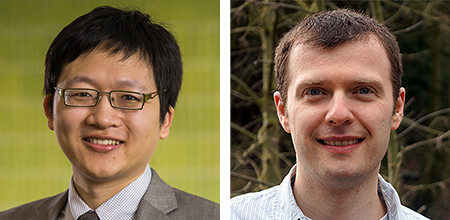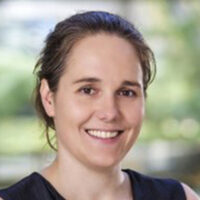
Grant for innovative research supports studies to combat e-waste, develop a carbon-sequestering biocement, and revolutionize the manufacturing of energy storage materials
By Andlinger Center for Energy and the Environment Communications
The Andlinger Center for Energy and the Environment has funded three projects through its Grant for Innovative Research in Energy and the Environment. One seeks to develop a systematic approach to minimizing the environmental impact of electronic systems. Another aims to develop a biocement that could transform the cement industry from carbon-emitting to carbon sequestering. The third explores alternative manufacturing methods for energy-storage materials in response to a growing demand for lithium-ion batteries.
Toward sustainable electronics

More than seven million metric tons of electronic waste (e-waste) are generated annually in the U.S., but only 35% of that e-waste is recycled – the rest is sent to landfills or exported. This e-waste crisis will only intensify as information technology and electric vehicles continue their rise.
A new collaborative research project seeks to gain a comprehensive understanding of the opportunities and challenges for sustainability in the electronics industry. Minjie Chen, assistant professor of electrical and computer engineering and the Andlinger Center for Energy and the Environment, will lead the research team, which also includes David Wentzlaff, associate professor of electrical and computer engineering, and Barry P. Rand, associate professor of electrical and computer engineering and the Andlinger Center for Energy and the Environment. The project aims to identify bottlenecks in the production of sustainable electronics and develop new electronic systems that minimize the environmental footprint of e-waste. The overall goal is to establish a systematic design method for sustainable electronics, ranging from materials and circuits to whole systems, such as computers. “Simply using sustainable materials is not enough,” Chen said. “We must know how these materials are going to be used and how to put different materials together to build a useful system for high-impact applications.”
The team is targeting both new materials that designers can use to create sustainable or biodegradable electronics and new device designs that can simplify recycling and make material recovery more efficient. The project seeks to take a step toward a future U.S. electronics industry with more recyclable materials and safely disposable, non-toxic devices.
“This is just a start,” Chen said. “Building a sustainable electronics ecosystem is not just an engineering problem, but also a societal problem.”
A carbon-sequestering biocement

The world’s built environment currently relies on concrete and steel, two construction materials that together are responsible for 14% of all anthropogenic CO2 emissions. For example, Portland cement is the second most-used resource on earth after water. Manufacturing Portland cement accounts for half of all emissions in concrete production because it involves the heating and decomposition of limestone, a carbonate material, primarily through the burning of fossil fuels.
A research team led by Claire White, associate professor of civil and environmental engineering and the Andlinger Center for Energy and the Environment, aims to create a new biocement that avoids emissions and instead acts as a CO2 sink. The researchers say this approach to transforming the industry from CO2-emitting to CO2-sequestering would be revolutionary. The approach hinges on using bacterial methods to create cement precursors from non-carbonate materials and then converting those precursors into carbonates via a reaction that takes CO2 out of the air and into the final cement. The team will investigate the fundamental nature of the key reactions, engineer bacteria capable of faster reaction rates, and explore novel additive manufacturing processes for deploying biocements in construction.

White will head up the interdisciplinary team that brings together bioengineering, material science, additive manufacturing, and behavioral science experts. José Avalos, associate professor of chemical and biological engineering and Andlinger Center for Energy and the Environment, will lead the team’s efforts in engineering the bacteria, while Reza Moini, assistant professor of civil and environmental engineering, will provide expertise in additive manufacturing with concrete. Complementing their efforts, Elke Weber, the Gerhard R. Andlinger Professor in Energy and the Environment, will guide behavioral science research to assess public and industry concerns around novel cements that could hinder efforts to shift away from current processes and materials. The researchers note that these issues are critical to address early in the development process so that engineers can better understand the concerns that various stakeholder groups have about biocements and can focus their research and design efforts around addressing them.
“This is the first time that I’ve incorporated biology into the research that my group does, and it’s very exciting and complex and rewarding,” White said. “This approach minimizes the need to manufacture industrial chemicals to get the process to work. Our hope is to exploit biology to enable technology.”
Inexpensive, low-waste, low-carbon cathode manufacturing
Electrifying transportation is a key component of pathways for reducing CO2 and pollutant emissions from fossil fuel-powered transportation. Currently, lithium-ion batteries (LiBs) are the industry standard for powering electric vehicles (EVs) and play a vital role in the electrification of the worldwide automotive industry. However, current materials used for the cathodes of LiBs are expensive and limit the energy capacity and thermal stability of contemporary batteries.
As the demand for LiBs grows, so does the need for low-cost, low-carbon emission, and high-performance cathode materials. A research group led by Yiguang Ju, the Robert Porter Patterson Professor of Mechanical and Aerospace Engineering, is studying non-equilibrium processing technologies that could allow for the manufacture of more energy-efficient and lower-waste cathode materials. The research group seeks to understand how to selectively manipulate the transport of ions and the rates of chemical reactions under the complex conditions of multiphase reactive flows, which are produced by pulsed heating and plasma discharge processes that are difficult to control.
Based on promising preliminary results from Ju’s lab and collaborators, they believe that fine-tuned manipulation of thermal and electric field gradients in these reactions will enable researchers to gain selective control over the flow of materials and, therefore, a route to shape the precise chemical structure of the final cathode materials. If successful, the research could create a foundation for transformational manufacturing and revolutionize the design and synthesis of energy storage materials by enabling new energy-efficient, low-waste, and low-carbon methods.

“Non-equilibrium processing is important for a wide range of activities, such as manufacturing for energy storage materials and moving away from using fossil fuels for heating,” said research team member Bruce Koel, professor of chemical and biological engineering. “This research is well-positioned to move Princeton forward and to contribute to solving some of these really important problems.”
In addition to Ju and Koel, the team includes Emily Carter, Gerhard R. Andlinger Professor in Energy and the Environment and senior strategic advisor for Sustainability Science at the Princeton Plasma Physics Laboratory, Craig Arnold, Susan Dod Brown Professor of Mechanical and Aerospace Engineering, Kelsey Hatzell, assistant professor of mechanical and aerospace engineering and Andlinger Center for Energy and the Environment, and Chung K. Law, Robert H. Goddard Professor.